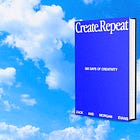You Can Just Make Things
Between selling out and burning out, there’s another way.
I remember being about six years old, picking up the family VHS camera and trying to direct my three friends in a “Star Wars” movie I wanted to make. The footage was a total mess, nothing made sense, and everyone had their own ideas about what the characters should do. But I had an idea in my head, I picked up the camera, and I made something, without a single thought about what anyone else might think.
Before I even knew what YouTube was, I was filming survival-style videos in my backyard, dressed up in my Indiana Jones outfit, explaining to an imaginary audience how to make a bow and arrow out of sticks and string if you were ever stranded in the woods.
There was no pressure. I was just a kid with an imagination making things I wanted to see. The execution was rough, it was years before I even learned how to transfer footage to a laptop and edit with Windows Movie Maker, but that didn’t matter.
In the professional world, making something is a lot more complicated. You need buy-in, funding, a team, a six-month strategy, twelve rounds of revisions before client approval etc. Then there’s the pressure of social media, where every piece of work you share might be seen by everyone from the kid you sat next to in eighth-grade math to your mom’s friends.
All of that weight feels so different from being a kid in the backyard with a camera, or experimenting with stop motion in Windows Movie Maker.
I’ve noticed a lot of people fall into two camps:
Camp One: is made up of people who trade their creative freedom for a “creative career.” They get paid to design, film, write, or build, but it’s almost never on their terms. They end up boxed into corporate projects that don’t light them up, churning out deliverables that fit someone else’s vision. They get to call themselves “a creative,” but they don’t really get to create.
Camp Two: is made up of people who refuse to play that game. They only make the art they want to see, the way they want to make it. But they spend so much energy just trying to survive without a steady paycheck that their creative work rarely gets the time and attention it deserves. The work stays “pure”, but the artist stays broke.
These two groups don’t capture everyone, but they do describe the starting point for most people. There’s a constant push and pull between chasing a corporate career in the arts, where you risk losing your voice, and going fully independent, where money (or the lack of it) becomes its own creative barrier.
What’s interesting is that both groups are wrestling with the same problem: they aren’t making the things they really want to make. One is trapped by deadlines and client briefs; the other is trapped by survival. Both end up distant from the joy that got them creating in the first place.
The people I see actually making the things they want to make are the ones who can move fluidly between those two groups.
A 9–5 in a creative field can be incredibly valuable. You get to sharpen your craft, collaborate with other talented professionals, and practice on projects you might not even care about that much, precisely because the stakes are low. It’s a training ground, a place to build skills and discipline.
At the same time, it’s equally important to pursue your own ideas. But that doesn’t mean running yourself into the ground with a draining part-time gig and then forcing yourself to make art on empty. It means creating in a way that’s healthy and sustainable, where your energy for personal projects isn’t completely consumed by survival.
To borrow from Dr. Ian Malcolm in Jurassic Park: “Life finds a way.” Wherever you are, let what you want to make find its way out. Don’t let your ideas wither. Pay attention to the ones that bubble up and get you so excited you’re willing to drop everything, those are the ones worth chasing. Push past the fear, pick up your tools, and make something.
We often forget the carefree motivation that got us started in the first place. When I was a kid filming those backyard videos, I wasn’t worried about strategy or approval. They were for me first, and the joy came from sharing them after.
As we get older, we build barriers, reasons why we can’t or shouldn’t start. The 9–5. Or the lack of one. The fear of judgment. The fear of failure. Not knowing where to begin. There are always a million excuses. But if you’re a writer, designer, filmmaker, photographer, whatever your medium is, you probably already have a few ideas sitting in the back of your mind. Things you’ve done nothing with, not because they don’t matter, but because you’ve convinced yourself you don’t have the time, the energy, or the right conditions.
All of the people I admire, their best work stands on top of a pile of experiments, or corporate projects they quietly used as practice. They honed their skills wherever they could, then used their extra time to make the things they actually wanted to see: a website, a magazine, a short film, whatever it was.
Wherever you are professionally, focus on sharpening your skills. And then just start making things. Use the mornings before work, the evenings after, the scraps of time you usually give away. Stop waiting for the perfect conditions, they’re never coming. Take advantage of what you have right now.
Because the truth is, you don’t know which project will matter. You don’t know which small experiment will stack up into something bigger. But none of that can happen if the idea just stays in your head.
So pick one. Make it, even if it’s rough. Learn what you can and move on to the next. That’s how momentum builds. That’s how you get back to the joy of it. You can just go make things.
Keep creating and repeating
- James
🛟 The Artist as Entrepreneur: Reflections on balancing creativity, business, and self-sufficiency as an artist.
🔲 Rebrand Gallery: A visual archive of recent brand redesigns and identity shifts. Explore design systems, visual identity introductions, and rebrand videos.
🖥️ People’s Graphic Design Archive: A community-driven collection preserving graphic design history. 🖥️
🥇 When Your Purpose is 1 of 1: Yancey Strickler on finding meaning in uniqueness and purpose.
Create.Repeat is a community for creatives.
The Create.Repeat Substack is a project designed to be a weekly diary on creativity. Sharing inspiration for artists to keep creating and repeating.
Written and curated by Zack Evans & James Warren Taylor
Each week we will be sharing recent thoughts on creativity, some links helping us stay creative, and a talent show featuring an artist from the community. Thank you for engaging with us.
History repeats. Create the future.











I’m about to embark on a new project and I needed to hear this. Thank you!
Well articulated, James.